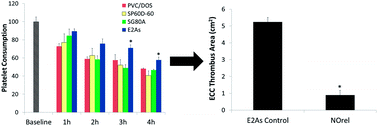Hemocompatibility comparison of biomedical grade polymers using rabbit thrombogenicity model for preparing nonthrombogenic nitric oxide releasing surfaces
Abstract
Nitric oxide (NO) is an endogenous vasodilator as well as natural inhibitor of platelet adhesion/activation. Nitric oxide releasing (NOrel) materials can be prepared by doping an NO donor species, such as diazeniumdiolated dibutylhexanediamine (DBHD/N2O2), within a polymer coating. The inherent hemocompatibility properties of the base polymer can also influence the efficiency of such NO release coatings. In this study, four biomedical grade polymers were evaluated in a 4 h rabbit model of thrombogenicity for their effects on extracorporeal circuit thrombus formation and circulating platelet count. At the end of 4 h, Elast-Eon E2As was found to preserve 58% of baseline platelets versus 48, 40, and 47% for PVC/DOS, Tecophilic SP-60D-60, and Tecoflex SG80A, respectively. Elast-Eon also had significantly lower clot area of 5.2 cm2 compared to 6.7, 6.1, and 6.9 cm2 for PVC/DOS, SP-60D-60, and SG80A, respectively. Based on the results obtained for the base polymer comparison study, DBHD/N2O2-doped E2As was evaluated in short-term (4 h) rabbit studies to observe the NO effects on prevention of clotting and preservation of platelet function. Platelet preservation for this optimal NO release formulation was 97% of baseline after 4 h, and clot area was 0.9 cm2 compared to 5.2 cm2 for controls, demonstrating that combining E2As with NO release provides a truly advanced hemocompatible polymer coating for extracorporeal circuits and potentially other blood contacting applications.


 Please wait while we load your content...
Please wait while we load your content...